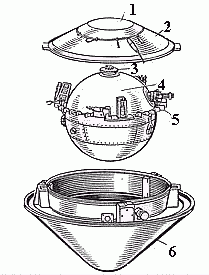List of spacecraft powered by non-rechargeable batteries
List of spacecraft powered by non-rechargeable batteries; spacecraft with non-recharged chemical batteries. A select group, but includes famous spacecraft such as Sputnik and Explorer 1, and the first landers for the Moon, Mars, Venus, Jupiter, and Saturn's moon Titan.
Unmanned
| What | Parent | Type of Battery | Notes |
|---|---|---|---|
| Deep Space 2 | Mars Polar Lander | Lithium-thionyl chloride [1] | Lost (1999) |
| ExoMars Schiaparelli | ExoMars Trace Gas Orbiter | Launched March 14, 2016 | |
| Explorer 1 | Zinc-Mercury oxide (Zn-HgO)[2] | Earth satellite (1958)[3] | |
| Explorer 8 | Mercury[4] | Earth satellite (1960) | |
| Explorer 17 (AE-A) | Earth satellite (1966) | ||
| Galileo Probe | Galileo | Lithium-sulfur dioxide[5] Ca/CaCrO4 (thermal) [6] |
Atmospheric entry into Jupiter (1995) |
| Huygens | Cassini | Lithium-sulfur dioxide (Li-SO2)[7] | Landed on Saturn's moon Titan (2004) |
| Luna 1 | Silver-zinc, Mercury oxide[8] | Lunar flyby, now derelict in heliocentric orbit (1959) | |
| Luna 10 | Lunar orbit (1966)[9] | ||
| Luna 11 | Lunar orbit (1966)[10] | ||
| Luna 24 (Ye-8-5M) | Lunar sample return (1976)[11] | ||
| Mars 2 & 3 landers | Mars 2 & 3 | Mars landers (1972)[12] | |
| Mercury-Scout 1 | Launch failure (1961)[13] | ||
| Pioneer 4 | Mercury[14] | derelict in heliocentric orbit (1959) | |
| Pioneer Venus Probes | Pioneer Venus Bus | Silver-Zinc (AgZn)[15] | Atmospheric entry into Venus (1978) |
| Phobos Hopper (Prop-F) | Phobos 2 | Lost (1989)[16] | |
| Sputnik | Silver-Zinc (AgZn)[17] | Earth satellite (1957) | |
| SuitSat | ISS | Earth satellite (2006) | |
| Venera landers | Veneras | Misc. Venus probes/landers | |
| Vega 1 & 2 Balloons | Vega 1 & 2 | Lithium[18] | Venus balloons (1985) |
| What | Parent | Type of Battery | Secondary | Notes |
|---|---|---|---|---|
| Luna 9 | Solar[19] | Lunar landing (1966) | ||
| Sojourner rover | Mars Pathfinder | Lithium-thionyl chloride (LiSOCL2)[20] | Solar | Roved Mars (1997) |
| Sputnik 3 | - | Silver-Zinc[21] | Solar (Experiment) | Earth satellite |
| Philae | Rosetta | Lithium-thionyl chloride (LiSOCl2) (900 W*h) Lithiu-ion (Li-ion) (100 W*h) | Solar | Comet 67P/Churyumov–Gerasimenko (2014)[22] |
| Vanguard 1 | Mercury[23] | Earth satellite (1958) | ||
Primary power comes from a chemical battery, but a secondary system exists. For example, Luna 9 ran out of power after three days.[19]

Pioneer Venus Large Probe (1-radio-transparent window, 2-tail protection, 3-antenna, 4-hermetic container, 5-sensors, 6-frontal protection)
Manned
- Space Shuttles, hydrogen-oxygen fuel cells[24]
- Gemini, early on silver-zinc,[25] later hydrogen-oxygen fuel cells[26]
- Mercury
- Apollo CSM, hydrogen-oxygen fuel cells[27]
- Apollo Lunar Lander, Ag-Zn[28]
- Soyuz 7K-T
- Vostok
- Voskshod
See also
References
- ↑ Mars Polar Lander/Deep Space 2
- ↑ G. Halpert, et al.- Batteries and Fuel Cells in Space
- ↑ Universe Today- Explorer 1
- ↑ Explorer 8
- ↑ NASA Quest
- ↑ B. Bienstock - Pioneer Venus and Galileo Entry Probe Heritage
- ↑ Huygen's Test - ESA
- ↑ Luna - Exploring the Moon
- ↑ NSSDC - Luna 10
- ↑ NSSDC - Luna 11
- ↑ Gunter - Luna Ye-8-5M
- ↑ Mars 2 lander
- ↑ Gunter - Mercury-Scout 1
- ↑ NSSDC - Pioneer 4
- ↑ J. Givens - Pioneer Venus & Galileo Probe Development
- ↑ A Scientific Rationale for Mobility in Planetary Environments (page 38)
- ↑ russianspaceweb
- ↑ Kramnev, et al - The Vega balloons (Page 2)
- 1 2 The Mission of Luna 9
- ↑ A Description of the Rover Sojourner
- ↑ Sputnik 3
- ↑ Ball, et al - Planetary Landers and Entry Probes - Page 244
- ↑ Early Unmanned NASA Craft (1957–1968)
- ↑ Fuel Cell Use in the Space Shuttle
- ↑ NSSDC - Gemini 4
- ↑ NSSDC - Gemini 8
- ↑ Fuel Cells
- ↑ Ball, et al - Planetary Landers and Entry Probes - Page 102
External links
This article is issued from Wikipedia - version of the 11/3/2016. The text is available under the Creative Commons Attribution/Share Alike but additional terms may apply for the media files.